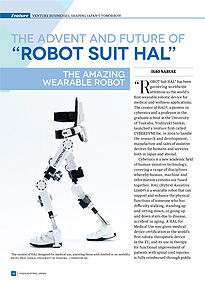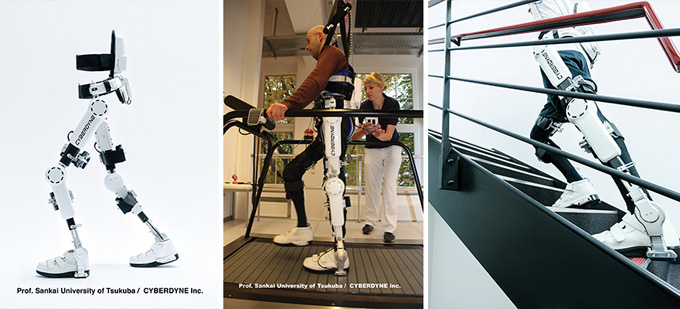Home > Highlighting JAPAN >Highlighting Japan September 2014>Venture Businesses: Shaping Japan’s Tomorrow
Highlighting JAPAN

Venture Businesses: Shaping Japan’s Tomorrow
The Advent and Future of "Robot Suit HAL"
The Amazing Wearable Robot

"Robot Suit HAL" has been garnering worldwide attention as the world's first wearable robotic device for medical and wellness applications. The creator of HAL®, a pioneer in cybernics and a professor in the graduate school at the University of Tsukuba, Yoshiyuki Sankai, launched a venture firm called CYBERDYNE Inc. in 2004 to handle the research and development, manufacture and sales of assistive devices for humans and services both in Japan and abroad.
Cybernics is a new academic field of human-assistive technology, covering a range of disciplines whereby human, machine and information systems are fused together. HAL (Hybrid Assistive Limb®) is a wearable robot that can support and enhance the physical functions of someone who has difficulty walking, standing up and sitting down, or going up and down stairs due to disease, accident or aging. A HAL for Medical Use was given medical-device certification as the world's first robotic therapeutic device in the EU, and its use in therapy for functional improvement of patients with spinal cord injuries is fully reimbursed through public workers' compensation insurance in Germany. About four hundred HAL robots are currently in use in Japan and around the world. In addition, models designed to support joint movement or reduce back strain, as well as a prototype model for use in disaster recovery, are in development.
So how does HAL work? HAL's sensors detect faint bioelectrical signals emitted by the brain that come to the skin's surface, and the "Cybernic Voluntary Control" system, which instantly processes the signals, enabling the body to move according to the wearer's intention.
Sometimes, however, those bioelectrical signals are not enough. For such situations HAL also has a "Cybernic Autonomous Control" system that senses such things as shifts in the center of gravity and anticipates the next move, which it then makes. This simultaneous operation of two systems to support a person's natural movements during volitional activity, which is HAL's basic principle, has been patented internationally and even singled out by the World Intellectual Property Organization as a patent to be noted.
Progress to reach that point, however, was not always smooth. Professor Sankai had to set up a company and gather both funding and people, slogging it out on a technically and mentally tough road to get where he is today. With nothing to precede HAL or compete with it, and since the technology was in a new field not covered by the safety policies of traditional industrial robots, HAL required its own rulebook. For that purpose, Professor Sankai became an expert member in medical robots of the International Organization for Standardization and took the lead in developing specifications. To the question, "What's innovation?" Professor Sankai once laconically replied, "If it's not there, make it." The professor believes that HAL will bring about an industrial and social transformation. An innovative technology is born from a situation of no market, no users, no industry, no professionals, and no social guidelines. Professor Sankai has managed to change each "no" into "new."
"Creating a new industry is possible even in Japan," Professor Sankai notes, and hopes HAL will become such an example. He says that the most necessary elements in creating a new industry are to have a philosophy and to take action, proclaiming as his belief, "Technology takes on meaning when it is useful to people and society." With Professor Sankai in charge and his philosophy resolute, CYBERDYNE Inc. will continue its drive for transformation.
© 2009 Cabinet Office, Government of Japan






